Aloe globuligemma
Aloe globuligemma Pole-Evans
Family: Asphodelaceae
Common names: knob aloe, button aloe (Eng.), knoppiesaalwyn (Afr.), lekopane (Sepedi (seKone dialect))
Introduction
Aloe globuligemma is an evergreen water-wise plant that has medicinal properties, its greyish leaves and striking inflorescences add character to a garden.
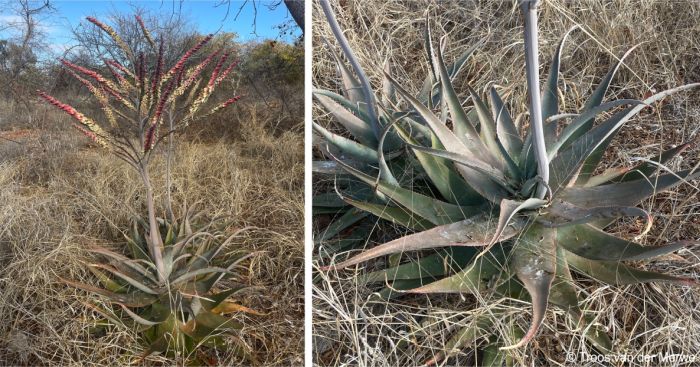
Description
Description
Aloe globuligemma is an evergreen, stemless succulent perennial which forms dense colonies by freely spreading as suckers. The plant is made up of a rosette of succulent leaves, 400-600 mm tall, the leaves are triangular, upward-pointing, inwardly curved with recurved tips and they have toothed margins. The colour of the leaves is often influenced by its surroundings, in dry conditions they are greyish green. This succulent graces the garden with an elongated inflorescence, up to 1 m tall, in the winter season (July to August) that produces 5 to 12 horizontal to ascending branches that carry upturned, trumpet shaped, ombre flowers, 18-25 mm long. Each floweris dull red in bud and as it opens it changes to ivory yellow towards the mouth of the flower and eventually the whole flower is yellow. The flower contains orange anthers on dark purple stamens and a whitish stigma. The fruit is a capsule, 25 x 13 mm, that later splits to release the seeds.
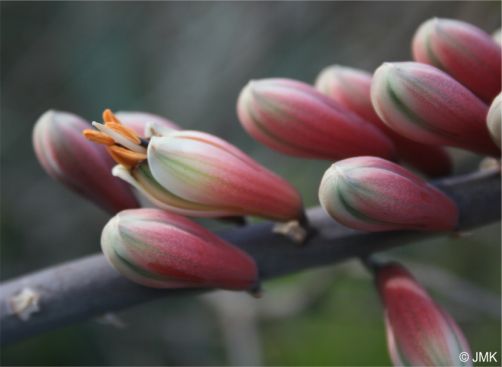
Aloe globuligemma may be confused with Aloe chabaudii, but the leaves of the knoppiesaalwyn are more recurved and they are more greyish in colour.
Conservation Status
Status
Aloe globuligemma is not an endangered species, currently, in its natural habitat, it is widespread and common, and is thus assessed as Least Concern (LC) by the Red List of South African Plants.
Distribution and habitat
Distribution description
Aloe globuligemma is native to the African continent, occurring in south-eastern Botswana, southern Zimbabwe and in northern South Africa where it is widespread across northern and eastern Limpopo Province, extending to the eastern Mpumalanga Lowveld. It occurs in rocky areas in hot, dry thorny bushveld and in hot and dry, bare or sparsely grassed areas, eroded places and open deciduous woodland.
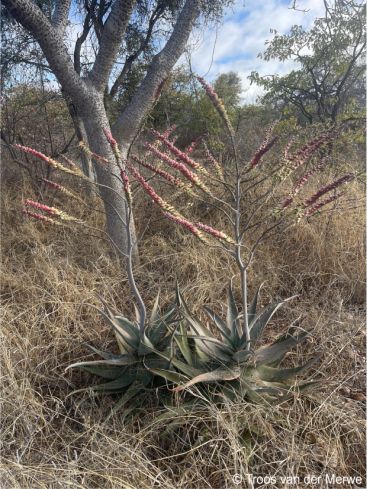
Derivation of name and historical aspects
History
The specific epithet globuligemma comes from the Latin words globulus and gemma, meaning ‘little ball’ and ‘bud’ respectively, describing the rounded buds.
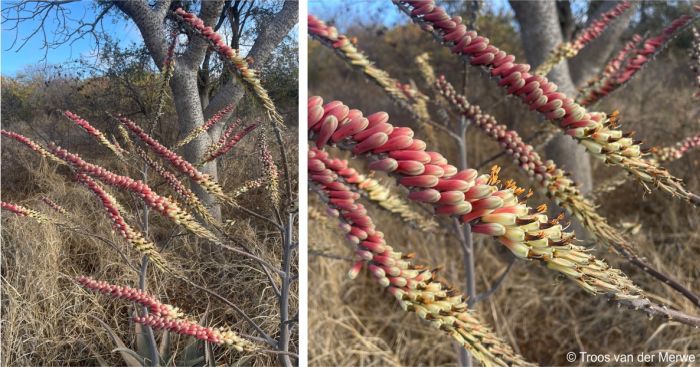
Ecology
Ecology
The flowers attract pollinating insects such as bees and butterflies, and nectar-feeding birds such as sunbirds. Rock hyraxes (dassies) eat the inflorescences in the Pretoria National Botanical Garden.

Uses
Use
In landscaping the plant is used for ornamental purposes especially in water-wise gardens where there is limited water supply. Aloe globuligemma is harvested from the wild for its medicinal properties and is used in traditional medicine to relieve stomach aches by infusion of the leaf. The plant sap is known to be poisonous so be cautious when using the plant for medicine as it could result in death. In Sekhukhuneland this plant is used for long-term weather forecasting, the direction that the terminal raceme points is thought to indicate if the coming rainy season will be good or poor.
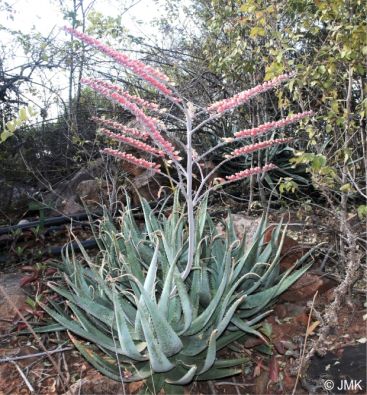
Growing Aloe globuligemma
Grow
Aloe globuligemma can be propagated by seeds sown in spring or early summer, in a sandy, well-drained potting soil. Germination takes about three weeks. The seed must be covered with a thin layer of sand and kept moist. The seedlings can be planted out in individual bags or containers as soon as they are large enough to handle. Transplanted plants and stem cuttings need moist but well-drained soil.
Grow this aloe in well-drained soil in full sun or semi-shade. It is ideally suited to dry bushveld or grassland gardens, rockeries and water-wise gardens, and is semi-hardy to frost. It is suitable for containers placed in a sunny, well-ventilated position. Take care not to overwater as this may cause root rot.
References
- Glen, H.F. & Hardy, D.S. 2000. Aloaceae (First part): Aloe. In: G. Germishuizen (ed.), Flora of Southern Africa, Vol. 5, Part 1, Fasc. 1: 1–159. National Botanical Institute, Pretoria.
- JMK. 2022. Image of Aloe globuligemma at Pretoria National Botanical Garden. Wikipedia. Online. https://commons.wikimedia.org/wiki/File:Aloe_globuligemma,_habitus,_Pretoria_NBT,_a.jpg.
- JMK. 2022. Image of part of inflorescence of Aloe globuligemma at Pretoria NBG. Wikipedia. Online. https://commons.wikimedia.org/wiki/File:Aloe_globuligemma,_bloeiwyse,_Pretoria_NBT,_a.jpg.
- Kativu, S. 2001. Asphodelaceae. In: G.V. Pope (ed). Flora Zambesiaca 12 (Part 3): 25-48. Royal Botanic Gardens, Kew.
- Plantbook. Aloe globuligemma. https://www.plantbook.co.za/aloe-globuligemma/. Accessed 29 April 2024.
- Raimondo, D., Von Staden, L., Foden, W., Victor, J.E., Helme, N.A., Turner, R.C., Kamundi, D.A. & Manyama, P.A. (eds). in press. Red List of South African plants. Strelitzia 25. South African National Biodiversity Institute, Pretoria.
- Useful Tropical Plants. Aloe globuligemma. https://tropical.theferns.info/viewtropical.php?id=Aloe+globuligemma. Accessed 29 April 2024.
- Van der Merwe, T. 2021. Observation of Aloe globuligemma in fruit, Musina, Limpopo. iNaturalist. Online. https://www.inaturalist.org/observations/95659190.
- Van der Merwe, T. 2023. Observation of Aloe globuligemma in flower, Musina, Limpopo. iNaturalist. Online. https://www.inaturalist.org/observations/176738740.
- Van Wyk, B. & Smith, G.F. 1996. Guide to the aloes of South Africa. Briza Publications, Pretoria.
Credits
Nondumiso Qwabe
National Zoological Gardens
June 2024
Acknowledgements: the author thanks Miss Zandile Mazibuko for helping with information and Troos van der Merwe and JMK for allowing the use of their images via iNaturalist and Wikipedia.
Plant Attributes:
Plant Type: Succulent
SA Distribution: Limpopo, Mpumalanga
Soil type: Sandy, Loam
Flowering season: Winter
PH: Acid, Neutral
Flower colour: Red, Yellow
Aspect: Full Sun, Morning Sun (Semi Shade), Afternoon Sun (Semi Shade)
Gardening skill: Average
Special Features:
Horticultural zones







Rate this article
Article well written and informative
Rate this plant
Is this an interesting plant?
Login to add your Comment
Back to topNot registered yet? Click here to register.